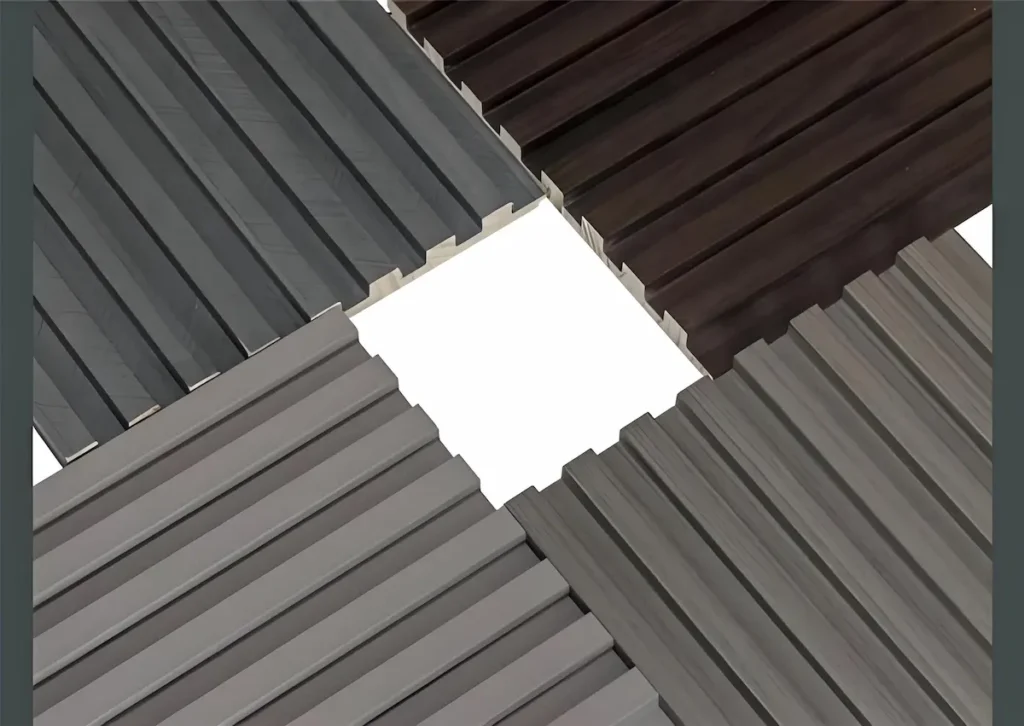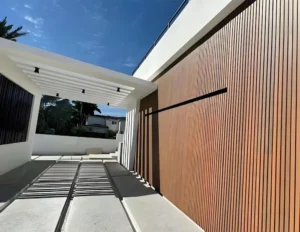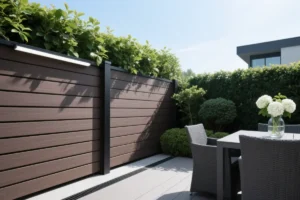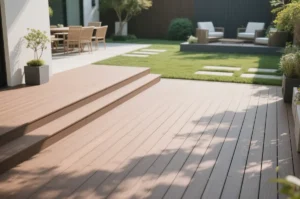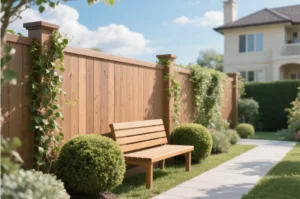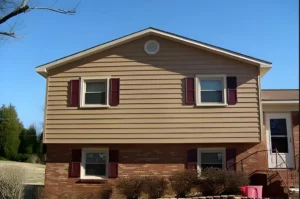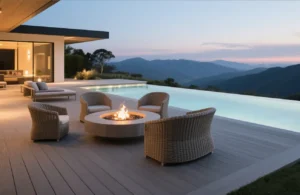WPC wall panels and PVC wall panels, two popular options for your home or commercial space, which will you choose? Both offer excellent durability, aesthetics, and ease of installation. However, they have distinct differences that make them suitable for different applications.
This guide explores the benefits of both materials, helping you decide which is best for your project.
What is WPC Wall Panel?
WPC wall panels (Wood Plastic Composite) are made from a blend of wood fibers and thermoplastics. This combination creates a strong, eco-friendly material that mimics the look of natural wood while offering enhanced durability.
Advantages of WPC Wall Panels
- Eco-Friendly Material – WPC uses recycled wood and plastic, reducing environmental impact.
- Natural Wood Aesthetic – It provides a realistic wood-like appearance without the maintenance of real timber.
- Water and Moisture Resistance – Unlike natural wood, WPC does not warp or rot when exposed to moisture.
- UV Resistance – Many WPC panels are treated to resist fading from sunlight.
- Low Maintenance – No need for painting or sealing, just occasional cleaning.
- Thermal Insulation – Helps regulate indoor temperatures, improving energy efficiency.
What Are PVC Wall Panels?
PVC (Polyvinyl Chloride) wall panels are made from rigid or flexible plastic. They are widely used in bathrooms, kitchens, and commercial spaces due to their waterproof properties.
Advantages of PVC Wall Panels
- 100% Waterproof – Ideal for high-moisture areas like bathrooms and kitchens.
- Lightweight and Easy to Install – Can be cut and fitted quickly without heavy tools.
- Affordable – Generally cheaper than WPC and other wall cladding options.
- Wide Variety of Designs – Available in wood, marble, and tile patterns.
- Mold and Mildew Resistant – Non-porous surface prevents bacterial growth.
- Durable and Long-Lasting – Resists scratches, dents, and impact damage.

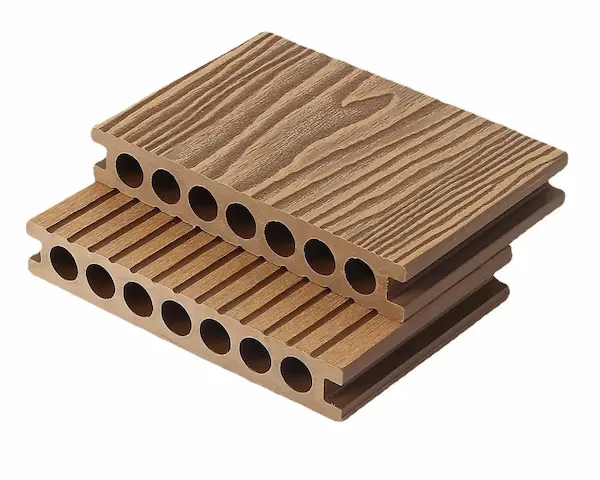
Technical Comparison: WPC vs PVC
Structural Properties
| Characteristic | WPC Wall Panels | PVC Wall Panels |
|---|---|---|
| Density | 1.1-1.3 g/cm³ | 1.3-1.5 g/cm³ |
| Thermal Expansion | 0.05-0.1% per °C | 0.08-0.12% per °C |
| Flexural Strength | 25-50 MPa | 40-60 MPa |
| Impact Resistance | High | Very High |
Environmental Considerations
WPC:
- Contains 50-70% renewable content
- Lower embodied energy than PVC
- Some formulations are biodegradable
PVC:
- 100% recyclable
- Modern formulations phthalate-free
- Long lifespan reduces waste
Application-Specific Recommendations
Best Uses for WPC Wall Panels
- Residential Living Spaces
- Feature walls in living rooms
- Bedroom accent walls
- Dining area paneling
- Commercial Applications
- Hotel lobbies and corridors
- Office reception areas
- Restaurant dining spaces
- Specialty Installations
- Balcony and patio walls
- Spa and wellness centers
- Outdoor kitchens
Ideal PVC Panel Applications
- High-Moisture Environments
- Complete bathroom solutions
- Kitchen backsplashes
- Laundry room walls
- Commercial Installations
- Hospital and clinic walls
- Laboratory surfaces
- Food processing areas
- Temporary or Rental Spaces
- Exhibition booths
- Pop-up retail spaces
- Rental property upgrades
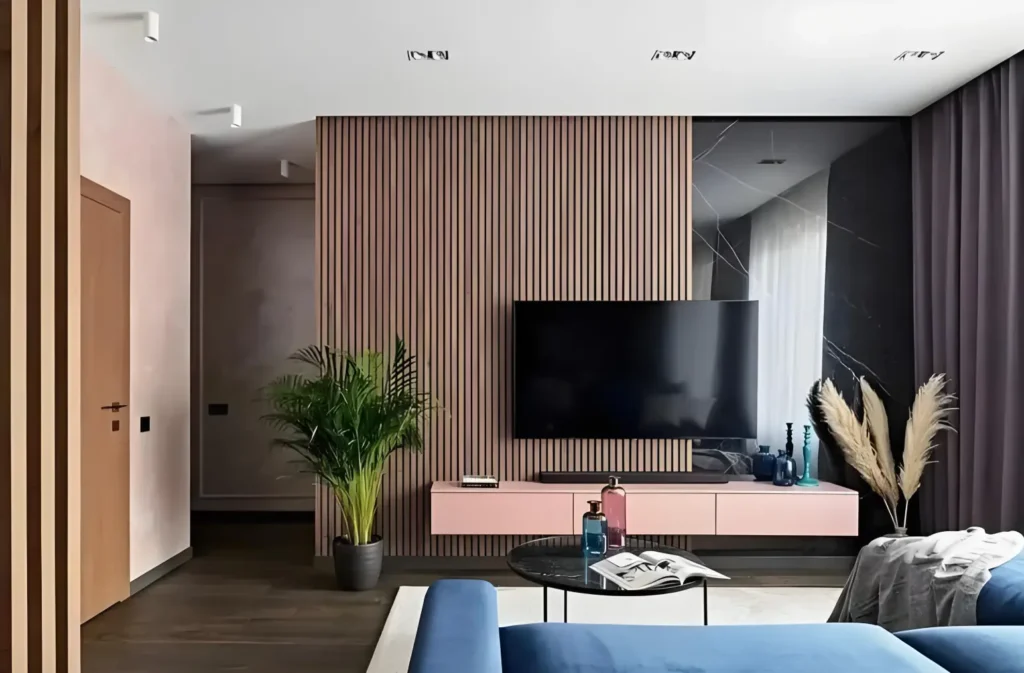
Installation Considerations
WPC wall Panel Installation
- Substrate Requirements
- Requires stable, flat surface
- Can be installed over:
- Plywood
- Concrete
- Existing drywall
- Fastening Methods
- Hidden clip systems
- Stainless steel screws
- Adhesive-assisted installation
- Expansion Gaps
- Require 5-8mm perimeter gaps
- Important for thermal movement
PVC wall Panel Installation
- Simple Installation Process
- Direct adhesive application
- Interlocking edge systems
- No special tools required
- Adaptable Solutions
- Can cover imperfect walls
- Installs over existing tiles
- Easy to cut and shape
Maintenance Comparison
WPC Maintenance Protocol:
- Annual inspection of fasteners
- Occasional deep cleaning
- UV protection for exterior use
PVC Maintenance Advantages:
- Never requires refinishing
- Stain-resistant surface
- Bleach-cleanable when needed
Cost Analysis Over Time
While PVC panels have lower initial costs (typically $2-$5 per square foot compared to WPC’s $4-$8 range), WPC panels often provide better long-term value for certain applications due to:
- Longer lifespan in exterior applications
- Higher perceived value in upscale projects
- Better insulation properties reducing energy costs
Making the Right Choice
Consider these decision factors:
- Budget Parameters
- Immediate vs long-term investment
- Environmental Priorities
- Recycled content vs recyclability
- Performance Needs
- Moisture exposure
- Traffic levels
- Aesthetic requirements
- Project Duration
- Permanent installation vs temporary solution
Industry Trends and Innovations
Recent developments in both materials include:
- WPC Advancements:
- Improved UV stabilizers
- Enhanced wood-like textures
- Fire-retardant formulations
- PVC Innovations:
- Antimicrobial coatings
- 3D textured surfaces
- Improved impact resistance
Professional Recommendations
For premium residential projects or commercial spaces where natural aesthetics matter, WPC wall panels deliver outstanding performance. In moisture-intensive environments or budget-conscious projects, PVC panels provide reliable solutions. Many designers now combine both materials, using each where it performs best.
Final Thoughts
Both WPC wall panels and PVC wall panels offer compelling advantages for modern construction and renovation projects. By understanding their unique properties and ideal applications, specifiers and homeowners can select the perfect solution for each space’s requirements. If you wonder whether WPC wall panel is safe, you can read this article: Are WPC Wall Panels Safe for Your Health?
For personalized advice on selecting between WPC and PVC wall panels for your specific project, consult with our design experts or request material samples to evaluate their look and feel firsthand. WPC Vs PVC, which one will you choose?

